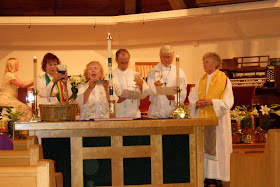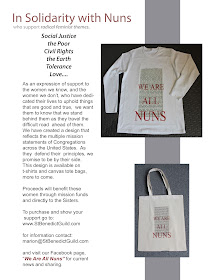A new spiritual uprising is rocking the Catholic Church today.At the Vatican we see the “Monsignors Mutiny”a tale of betrayal, corruption and power struggles that has the potential of becoming a blockbuster movie that could rival the Da Vinci Code. One Italian paper even suggested that an unnamed laywoman had secretly ordered the butler to leak the secret documents which is referred to as the Vati-leaks. But the Vatican, of course, denies it all...” http://www.thedailybeast.com/articles/2012/05/30/the-pope-s-butler-silenced-in-vatileaks-investigation.html
In May 2012, hundreds of Irish priests called for an end to mandatory celibacy and for women’s ordination in an unprecedented challenge to the Vatican. http://www.cathnews.com/article.aspx?aeid=31216
Like the woman in Luke’s
Gospel whom Jesus declared free after being bent over for eighteen years, the
Spirit is a movin’ in the courageous nuns. In response to the Vatican’s rebuke
of the Leadership Conference of Women Religious for their support of women’s ordination, homosexuality and contraception,
the Sisters are planning a bus trip to nine states to showcase their ministry
to the poor and disenfranchised.
 |
| Thousands of Catholics have attended prayer vigils and signed petitions in solidarity with the Sisters in the Nun Justice Project. One day, I hope we will have nun priests! http://www.nytimes.com/2012/06/06/us/us-nuns-bus-tour-to-spotlight-social-issues.html?_r=2&emc=eta1 |
The Spirit is a movin’
in the women priests movement as we live Gospel equality now and ordain women
like Donna Rougeux.
Donna will be ordained a
Roman Catholic Woman Priest in the second ordination of a woman priest in
Lexington, Kentucky in the Unitarian Universalist Sanctuary.
Together with
Janice Sevre-Duszynska, the first woman ordained here four years ago, Donna is
standing up in solidarity with all who are oppressed and marginalized for
justice. As a woman priest, she is leading, not leaving the Catholic Church
into a new era of inclusivity, partnership, equality and openness where all are
welcome to receive sacraments. Everyone belongs at the Banquet Table of God’s
boundless, abundant love. As the Irish writer, James Joyce, reminded us in Finnegan’s Wake, being Catholic means “here comes everybody.”
In Luke 13:10-13, when
the synagogue leader expressed outrage that Jesus had healed on the Sabbath,
Jesus called the religious leaders, hypocrites and pointed out that this
healing was for a daughter of Abraham and Sarah, who had suffered for 18 years.
So, there are several take home messages here: 1) Jesus treated women as
equals. 2) People have priority over rules and regulations. 3) Sexism is sinful
and should always be challenged. 4) Our Compassionate God lifts up all who are
bent over by the burden of patriarchy.
The good news is that the Spirit of God is renewing the church in a spiritual uprising in vibrant, grassroots communities.
where the liturgical presiders include women priests, married priests, celibate priests and other leaders.
The good news is that the Spirit of God is renewing the church in a spiritual uprising in vibrant, grassroots communities.
where the liturgical presiders include women priests, married priests, celibate priests and other leaders.
We are living witnesses to the transformation, that one day will be affirmed in Vatican III, a Council of the People of God. Joel describes this passionate, outpouring of divine love on humankind in these words: “Your daughters and sons will prophesy, your elders will have prophetic dreams and your young people will see visions. I will pour out my Spirit even on those in servitude, women and men alike.” (Joel 3:1)
The institutional church
is trying to keep women bent over when it refuses to recognize their call to
the priesthood. No longer will we tolerate the Vatican’s practice of sexism,
which is rooted in the misogynist attitude of church fathers like Tertullian
who once said that women are the “gateway to the devil” and Thomas Aquinas who
defined woman as a “defective male.”
In a modern day
inquisition, the Girl Scouts are facing an official inquiry by the United
States Conference of Catholic Bishops. The problem is their association with
groups like Doctors Without Borders, Oxfam, and the Sierra Club because these
organizations support contraception and family. We challenge the bishops for
their unjust attack and stand in solidarity
with the Girl Scouts for their program of empowerment of girls. Let us feast on
Girl Scout Cookies often!
If women priests were
decision-makers in our church, women’s health care including contraception and
universal health coverage would be major justice issues. We believe women have
the divinely human right to make reproductive decisions on their own behalf
--without consulting male priests or bishops. 98% of sexually-active
Catholic women have used a method of contraception banned by the U.S. bishops.
A spiritual uprising in theology is evident today in the
thinking of brilliant theologians like
Elisabeth Johnson, author of Quest for the Living God Mapping Frontiers in
the Theology of God, and Sr. Margaret Farley, author of Just love, A Framework for Christian Sexual Ethics. Both books have been denounced by the
hierarchy. After the pope censured Farley’s book, which is a contemporary
ethical approach to same-sex relationships, masturbation, remarriage after
divorce, it soared
from obscurity to the top of
Amazon.com’s best-seller list - six years after it was published. In her book, Sr. Farley argues that same-sex
marriage “can also be important in transforming the hatred, rejection, and
stigmatization of gays and lesbians.” She wrote that “same-sex relationships
and activities can be justified according to the same sexual ethic as
heterosexual relationships and activities.” http://www.nytimes.com/2012/06/05/us/sister-margaret-farley-denounced-by-vatican.html
Women are silent and
invisible and subordinate no more! We are speaking truth to power and the
ministry of irritation is our forte!
Roman Catholic Women
Priests Janice and Ree Hudson and Deacon Donna went to Rome last October to
support Fr. Roy Bourgeois who four years ago stood here to witness for justice
at Janice’s ordination. As you remember that resulted in big trouble for Roy,
which has played out like an ecclesiastical soap opera!
In her own words, Donna
shared this inspiring testimony explaining why she chose today’s reading for
her ordination. “I am like the woman in the story who after Jesus laid his hand
upon me, ‘stood up straight and began thanking God…’”
“In Ephesians (3:17-21)
we read: ‘I pray that God, out of the riches of divine glory, will strengthen
you inwardly with power through the working of the Spirit.’ I believe this is
what happened to the bent over woman and to me. We were strengthened inwardly.
I also think that until this happens we are unable to ‘grasp fully the breadth,
length, height and depth of Christ's love.’ Christ's love is not just about
putting on an 'all is well attitude'...It also involves working for justice and
not just trying to please everyone to keep the peace. When we stand up and work
to bring about the kin-dom, we don't make everyone happy. We even encounter
excommunication and disdain from some. Standing up with inward strength means
we have to rock the boat and that makes some people very unhappy. But it also
brings us in a place where we can grasp more fully the breadth, length, height
and depth of Christ's love.’”Amen, Donna, to rocking the boat of Peter and
walking on water with Christ! I
guarantee that you are in for quite a spiritual adventure!
I believe that on a deep
spiritual, mystical level women priests are beginning a healing process
of centuries-old deep misogyny in which spiritual power was invested
exclusively in men.
For some like the Catholic hierarchy, women priests are a
spiritual uprising. For millions of people the time has come for a holy shakeup
that will bring new life, creativity and justice to the church and beyond.
The New Testament
identifies the crucified Christ with the Wisdom of God. “…to those who are
called, Christ is the power and the wisdom of God.” (1 Cor. 24 The connection
in scripture is made between the crucified Jesus of Nazareth and the cosmic
Risen Christ in Christ-Sophia. In this liturgy today we integrate this powerful
image of Christ- Sophia in our prayer and song.
Thanks to our music director, Kathleen Rosenberg, for the beautiful musical Mass of Christ-Sophia which she composed.
Now we ordain our beloved sister, Donna, who like the woman whom Jesus set free in the Gospel, will share God’s healing compassion with all those she encounters in her ministry. Like the woman who was healed in the Gospel, we, too, are set free to work for justice and to live Gospel equality now!
Thanks to our music director, Kathleen Rosenberg, for the beautiful musical Mass of Christ-Sophia which she composed.





















